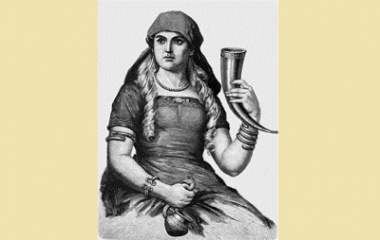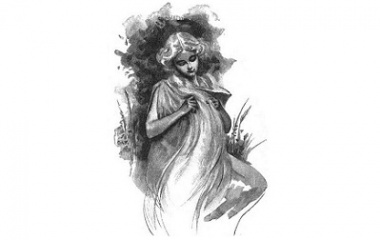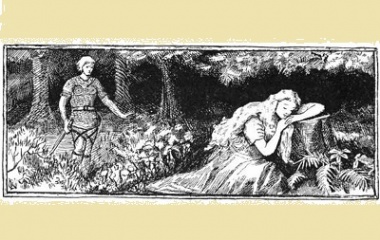- Pronunciation: SIFF
- Origin: Norse
- Role: Goddess
- Symbol: Golden Hair
- Children: Ullr
- Husband: Thor
Who Is Sif?
Sif was a Norse goddess and wife of the warrior god Thor. Her legacy has been overshadowed by that of her husband but she was at one time a highly recognized and important deity. She was the goddess of wheat, fertility and family. There are very few details surround the goddess but what we do know about her shows that she was a very important god to the Norse people.
Origins
The two main texts that depict Sif are the Poetic Edda and the Prose Edda, some of the best known traditional sources on Norse mythology. She is described as a beautiful woman with hair that was as golden as the sun. Her name means “relation to marriage” and she was associated with family caregiving and fertility. Thor was her second husband, with her first being the Giant Orvandil. She is often compared to other goddesses like Freya or Fjorgyn.
Legends and Stories
Myths that involve Sif are many but her roles are passive. This isn’t to say that she wasn’t an important goddess. Her importance to Norse mythology is mainly in her symbolic contributions.
Sif’s Hair
Thor, Sif’s husband, was known for his tough and masculine reputation. But he was absolutely in love with Sif, who was incredibly beautiful. Her most famous physical attribute was her long and thick hair that was the most perfect shade of gold. It flowed far down her back and always appeared to be flawless.
It is said that her long golden hair represented wheat and she was responsible for the Norse people’s crops. She would travel, seeking families and farms, where she would protect the crops from the cold winds and winters.
Sif would brush her hair with a comb encrusted in jewels and wash it in sparkling streams. To get it to dry, she would lay it out on rocks and let the sun’s warmth speed up the process. It was on one of these days that she fell asleep while waiting for her hair to try. Loki, the god of fire and mischief, had cast a spell on her so that he would be able to play with her hair.
Thor treasured his wife’s hair and would often boast of it whenever given the opportunity. Loki knew this and in an effort to upset the god, he chopped off Sif’s hair. Sif was left nearly bald and when she awoke, she found her hair in piles around her. She burst into tears and they fell onto the ground below, flooding the crop fields that she would protect.
Thor called for his wife but was unable to find her. After searching, he finally heard her whisper his name. She declared that she was ashamed and needed to leave the home of the gods and go into hiding. She then let her husband see her and he was immediately struck with sadness for his wife’s suffering.
Thor approached the other gods, demanding that they tell him who did this to his wife. Odin, the chief of the gods, suggested that it was Loki, as no one else had enough mischief in them to do such a thing. Odin called Loki, only after he commanded Thor to not harm him.
Loki admitted to the crime and the gods demanded he find a way to make amends. Loki left to find a way to give Sif her hair back. He traveled to the center of the earth to visit the Gnomes, who were known for their handiwork. He asked them to make a cap of floor-length hair that would match Sif’s hair. The Gnomes worked for days but eventually they presented the cap to Loki, which sported long golden locks as soft as silk made from gold thread.
He brought it to Sif, who put it on. It fit perfectly and gave her back her hair that she had missed so terribly. She was once again happy and was able to help the Norse with their crops once again.
Family
There is very little known about Sif’s own family. While we know she was married to Thor, we don’t know if they had any children. She did have a child from her first husband named Ullr. He was the god of snowshoes, hunting, the bow and she shield. He was described as being incredibly handsome with many warrior-like attributes. He was often called upon for help in battles.
Appearance
Artistic representations of Sif always show a young and strikingly beautiful woman with long, flowing golden hair. In most pictures, the hair is nearly touching the ground. It can be argued that without her long hair, it would be hard to recognize Sif as there is very little description of her otherwise.
Symbology
Sif is said to symbolize fidelity. She is also associated with summer, passion and the sun. Her best symbol though is her hair, which was said to symbolize the crop fields of the Norse population. The health of her hair was directly related to the strength of the crop, specifically wheat according to some sources. An old tradition says that in order to ask Sif for help, one should bake bread with plenty of grains. Sif is also associated with light, as it is said she was able to control the light in the sky and had a hand in the changing of seasons.
Pop Culture
While not proven, it is assumed that Sif is mentioned in the famous Old English poem Beowulf. She is also celebrated at the end of spring every year, as Sif was associated with summer. On the first day of the new season, there seems to be a spark of interest in the story of the goddess in Iceland. Thanks to the written work of a 19th century researcher, the story of Sif was rejuvenated in Scandinavian folklore. Iceland began to build a Norse temple in 2015 to pay tribute to Thor, Odin and Frigg. Because of this, Sif has grown in popularity once again.










